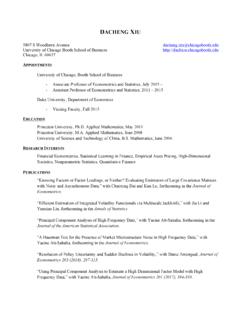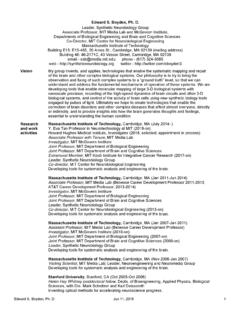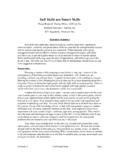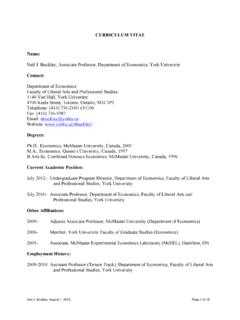Transcription of FDI BETWEEN EU MEMBER STATES: GRAVITY …
1 FDI BETWEEN EU MEMBER states : GRAVITY model AND TAXES1 Pawe Folfas Warsaw School of Economics Institute of International Economics Abstract GRAVITY models utilize the attractive force concept as an analogy to explain volume of trade, capital flows and migration among the countries of the world. A fundamental goal of my paper is to prove that direct investment flows BETWEEN EU MEMBER states are determined by standard variables included in GRAVITY models such as: gross domestic products (total and per capita) of home and host economy and distance BETWEEN them. In my GRAVITY model of FDI I include not only geographic distance but also variables illustrating economic distance, namely: membership in euro area, cultural similarity, duration of membership in the EU (EC). Additionally, my model encompasses variables linked with tax policy of EU MEMBER states . I prove that differences in corporate tax burdens determine FDI flows.
2 states with simpler and lower taxes allure more direct capital. Especially, model confirms that European offshore financial centers: Cyprus, Luxembourg and Malta play a significant role in intra-EU direct capital flows. On one hand, my model includes time invariant variables, so the model with fixed effects is not proper. On the other hand, as individual effects might be correlated with some independent variables, model with random effects can be also not adequate. Consequently, I use Hausman-Taylor estimator. My FDI GRAVITY model is based mainly on OECD and WDI databases concerning two last decades. Keywords: FDI, GRAVITY model , the European Union, corporate taxes JEL codes: F14, F15, F21 1 Participation in ETSG 2011 Conference was financed from doctoral scholarship of National Science Centre (No. of agreement 3953/B/H03/2011/40). Text includes partial results of PhD research.
3 2 2 1. Background studies on GRAVITY models of foreign direct investments GRAVITY models appear as an adaptation of the law of universal gravitation3 for socioeconomic phenomena. For the first time the law of gravitation was applied to social science by Carey [1858, pp. 42, 88 90, 371 373, 465]. According to Carey phenomena in physics and in social science are determined by similar laws and the gravitational attraction is also present as a molecular GRAVITY in a society . He claimed that more people in some area means stronger social attractive force which is directly proportional to the mass of people and inversely proportional to the distance (not only geographic, but also social or psychological distance) BETWEEN persons. Carey launched studies based on GRAVITY models which focused on determinants of masses behaviour, especially interdependence BETWEEN size of population, distance and attractive force BETWEEN people.
4 GRAVITY models became tools in analyzing: size of migrations and trade, number of phone calls and number of passengers and goods in transport. These studies concerned the attractive force BETWEEN masses of people living in different regions of single country4. In 1960s GRAVITY models were applied to analyzing international trade flows. Pioneers in these studies were: Linemann [1963], P yh nen [1963], Pullainen [1963] and Tinbergen [1962]. They were conducting independent and simultaneous studies which brought similar results. However the most known is study proposed by Tinbergen who was announced as a discoverer of GRAVITY law ( GRAVITY equation) in international economics (see equation (1)). (1) dijbjaiijDYYCX where notation is defined as follows: Xij international flow from reporter i (origin country) to partner j (destination country) or the sum of the flows in both directions (for example: export, import or sum of export and import values; size of migration, foreign direct investment, tourism), Yi(j) economic sizes of the two locations (for example: GDP, population, endowment of labour, land or capital), Dij distance BETWEEN the locations (usually BETWEEN their economic centres), 3 In 1687, Newton proposed the law of universal gravitations which states states that every point mass in the universe attracts every other point mass with a force that is directly proportional to the product of their masses and inversely proportional to the square of the distance BETWEEN them.
5 4 See for example: Ravenstein [1885], Reilly [1929], Stewart [1948], Converse [1949], Zipf [1949], Dodd [1950], Hammer and Ikle [1957]. 3 G gravitational constant, a, b and d elasticity of Xij to change in Yi, Yj and Dij. Since Tinbergen s study the GRAVITY equation has been one of the most popular empirical equations that has been successfully used to analyze the wide spectrum of interactions in international economics. The GRAVITY equation postulates that the amount of flow BETWEEN two locations increases in their economic sizes and decreases in the cost of transportation BETWEEN them as measured by the distance BETWEEN economic centres of locations. However, there are many variables which can embody economic masses of locations. In studies of bilateral trade and direct investment flows the economic size of the exporting and importing countries are usually measured by gross domestic product.
6 However economic size can be also measured by: gross national product, gross domestic product and population, gross domestic product per capita or endowment of production factors (absolute value or per capita). Therefore, there are a number methods of measuring gross domestic products: in current prices, in constant prices or in purchasing power parity. It is debatable which measure is the most adequate for GRAVITY models. In my opinion, as international flows of trade or capital are measured in current prices, gross domestic product in current prices is the most proper. Additionally, gross domestic products in PPP distort the difference BETWEEN countries, as their values are higher for developing countries and lower for developed economies [Czarny, Folfas 2011, pp. 5 6]. Distance in the law of universal gravitation illustrates resistance to attractive force BETWEEN point masses.
7 In international economics resistance to GRAVITY force BETWEEN locations is embodied by all factors which hamper international flows of goods, services, capital, labour and technology. These factors can be divided in two groups: economic and noneconomic. The first group encompasses: geographic distance BETWEEN economic centres of locations, adjacency, characteristics of geographic location (island, landlocked country), cultural similarity (common languages, colonial links), volatility of exchange rates (common currency, exchange rate regime), tariffs and nontariffs trade barriers, membership in international organizations (free trade areas, custom unions, common markets, economic and monetary unions) and the quality of infrastructure. The second group includes: regulations, political conflicts and environmental barriers [Head 2000, pp. 5 10]. Moreover, there are a few candidates for dependent variable in GRAVITY models.
8 Bilateral international flows can be illustrated by: export, import or sum of both of them. In 4 the case of international trade, exports value is not distorted by tariffs, nontariffs barriers and cost of transport and insurance. However data concerning imports are more precise thanks to the registration linked with customs duties (data concerning exports are usually based on tax returns). Taking into consideration a sum of export and import is the most complete method, however it meets difficulties with gaps in data. In the case of foreign direct investments and other capital flows data concerning inflows are more precise than data concerning outflows, which usually are riddled with gaps [Czarny, Folfas 2011, p. 7]. Popularity of GRAVITY models in empirical studies concerning international trade in goods and services and international movements of production factors has encouraged economist to create theoretical foundations of GRAVITY law, especially GRAVITY model of international trade.
9 To the most important belong studies conducted by: Anderson [1979], Bergstrand [1985, 1989], Helpman [1987], Deardoff [1998], Anderson and van Wincoop [2003], Feenstra [2004], Haveman and Hummels [2004], Debaere [2005], Helpman, Melitz and Rubinstein [2008]. The majority of mentioned authors conducted empirical studies of bilateral trade based on different version of GRAVITY models5. Generally, GRAVITY model is a kind of short-hand representation of supply and demand forces. If Xij represents exports and if the country i is the origin, then Yi represents the amount it is willing to supply. Meanwhile Yj represents the amount destination j demands, in other words the amount of income country j spends on all goods from any source i. Big economies with high income usually spend a lot of money on import. They are also able to allure quite big share of other economies expenditures (so they are able to export a lot of goods) because they produce goods in wide variety.
10 Consequently, the amount of export is higher due to big economic size at least of one partner [Head 2000, p. 3; Krugman, Obstfeld 2007, pp. 25 29]. GRAVITY model has become one of the most popular and successful analytical tool in international economics, especially due to its high explanatory power and easily available data in studies concerning international trade of goods. However, recently GRAVITY model has become very popular analytical tool also in explaining bilateral flows of capital, especially in explaining determinants of foreign direct investments (FDI). Unfortunately construction of FDI GRAVITY models meets a number of additional obstacles. Firstly, the values of bilateral FDI flows are available only for selected countries, mostly for developed countries (OECD, UE) or countries from one region. Consequently, construction of FDI GRAVITY models for all (even the majority) countries of the world seems to be not possible.






